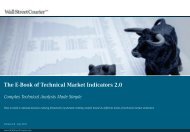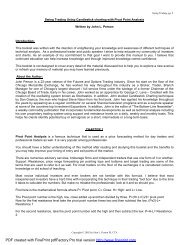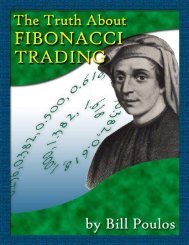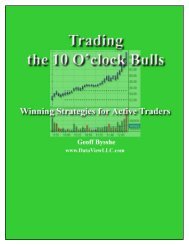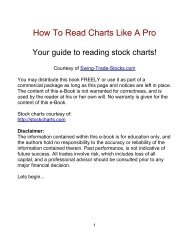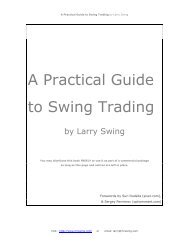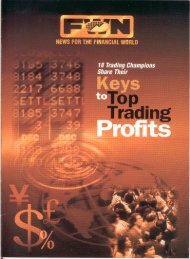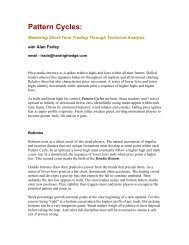3 swing trading examples, with charts - The Swing Trading Guide
3 swing trading examples, with charts - The Swing Trading Guide
3 swing trading examples, with charts - The Swing Trading Guide
You also want an ePaper? Increase the reach of your titles
YUMPU automatically turns print PDFs into web optimized ePapers that Google loves.
3 SWING TRADING EXAMPLES, WITH CHARTS,INSTRUCTIONS, AND DEFINITIONS TO GET YOU STARTEDBy Alan Farley<strong>The</strong> following <strong>examples</strong> cover common areas of <strong>swing</strong> <strong>trading</strong> that will provide insight into themechanics of the <strong>swing</strong> trade. Following the three <strong>examples</strong>, I provide a glossary of terms that areessential to understanding the basics of <strong>swing</strong> <strong>trading</strong>. I hope the combination will set you onyour way to success.Amazon.com (AMZN:Nasdaq) [dated 11/20/01]Net stocks aren't flying very high anymore, but they're still setting up nice <strong>swing</strong> trades. Aftergetting pummeled for months, many of these stocks are bouncing off multiyear lows. Driven byoptimism that things can't get any worse, market players have finally reawakened the Net rally.But pick your trades wisely. With few exceptions, Net stocks face an extraordinary burden ofoverhead supply. Vast legions of investors and institutions are still holding these stocks frommuch higher prices. <strong>The</strong>y will sell out their diminished portfolios for years to come.Many of these stocks are now <strong>trading</strong> in the single digits – a situation that demands carefulevaluation of position size and risk tolerance. <strong>The</strong> good news is the massive liquidity and smallspreads of the sector's largest stocks. <strong>The</strong>se high-float issues can trade all day <strong>with</strong> a single pennymarking the difference between the buying and selling price. This small transaction cost hasanother advantage. We can safely juggle in and out of a position several times to catch the bestentry price.Most Net rallies are only bear-market bounces. This fact raises the odds that resistance at stocks'200-day moving averages will extinguish their progress. In fact, the king of the jungle we'll lookat today should encounter that gorilla very soon.So play the Net rallies and enjoy the good old days. But keep those stops tight and take what themarket gives you. Fortunately, that could be double-digit gains at these discount prices.
Amazon.com (AMZN:Nasdaq) got crushed when the bubble burst, losing over 90% of its value.But times may be changing for the online retailer. <strong>The</strong> last few weeks finally delivered somegood news and the stock rallied about 50% off its October low. It now sits just under $10. Not ahuge ramp for the former giant, but accumulation suggests a bottom may near. Notice the bigmove on Nov. 14. It drove Amazon above its 50-day moving average, right into a test of the lasthigh.While volume shows investor interest, Amazon could be headed into a broader basing patterninstead of a breakout. Notice the lines drawn across recent highs and lows. <strong>The</strong>y take on theappearance of a partially developed symmetrical triangle. A stock needs to eject quickly out of abox like this, or it can easily drop all the way back to the lower trend line.
<strong>The</strong> volatility zone between $9.50 and $10 raises another caution flag. As you can see, sharpreversals characterize these price levels. Why does this happen? Certain chart points hidesignificant numbers of traders and investors sitting in losing positions, because they bought intosudden reversals. This volatility needs to be unwound before price can move past it.<strong>The</strong> key to this trade is the market number $10. If Amazon can mount it, it will complete twobullish patterns and draw in new buyers. First, it would trigger a cup-and-handle breakout on theshorter-term chart. More importantly, it would confirm a well-formed double bottom on the dailychart.
<strong>The</strong> best <strong>trading</strong> plan might be to go long before the breakout. Consider a position using theintraday pattern, but be prepared to exit quickly if larger forces intercede. For example, a breakabove the small triangle could offer the perfect entry for a larger price move. But avoid anyposition near the bottom of this pattern. It has the look of a bearish descending triangle. We couldsee a decent selloff if that lower line breaks.Concentrate on good trade management if you work this position into a profit. As I mentionedabove, strong resistance will stall most bear-market rallies at the 200-day moving average. Thisformidable barrier is sitting near $12 on Amazon's daily chart. <strong>The</strong> hot spot also crosses the majordown trend line for the entire postbubble collapse. We should take our profits if and when priceapproaches this danger zone.Nvidia (NVDA:Nasdaq) [dated 12/04/01]Computer gaming has traveled light years since Pong was first released in the 1970s. Fortune 500companies now cater to a game habit measured in the billions of dollars. In fact, 2001 industryrevenue will rival worldwide movie and DVD sales. This time-wasting endeavor has moved wellbeyond its core teenage audience into a variety of demographics.<strong>The</strong> game sector also represents an endangered species for traders: a technology bull market.Enthusiastic buyers are loading up on a new generation of boards, boxes and game titles. Equitieskeep running to catch up <strong>with</strong> this strong demand, and most stocks sit very close to multiyearhighs.You can attempt to profit <strong>with</strong> trade setups in the gaming sector. But forget about direct plays onthe boxmakers themselves. Microsoft (MSFT:Nasdaq) (Xbox) and Sony (SNE:NYSE ADR)
(PlayStation 2) have core interests unaffected by industry sales. Japanese giant Nintendo(GameCube) has no ADR (American Depository Receipt) <strong>trading</strong> on the American markets.Nvidia, a boardmaker, is another story, however. Nvidia rose from mediocrity to become thepowerhouse in 3-D chips, boards and technology. <strong>The</strong> Nvidia chipset in Microsoft's Xbox ensuresits industry leadership for years to come. Nvidia has been pushing through a series of all-timehighs throughout its relationship <strong>with</strong> Microsoft. But it has never generated very strongmomentum after each high and has fallen back over and over again to retest lower ground.What will it take for Nvidia to finally break out of the top of its rising trend line? <strong>The</strong> volumespike on Nov. 29 might offer a clue. It conceals a false breakout that caught many longs in a bulltrap. Until Nvidia can absorb overhead supply created by this ugly reversal, it will be difficult forany rally to generate momentum.Nvidia sits at a price pivot where it could start another run at the short-term high. Or it could justroll over here and retest the $40s. <strong>The</strong> small Island Reversal formed last week might speed upevents. Many traders probably noticed it and entered new short sales. <strong>The</strong> stock will need to fillthe gap and trade above $54 in a hurry, or the shorts (plus overhead supply) could kick in <strong>with</strong> avengeance.
Alkermes (ALKS:Nasdaq) [dated 11/29/01]At a training session a while ago I asked the crowd about their <strong>trading</strong> habits. Specifically, Iwanted to know how often they sold short. To my amazement, less than 25% said they ever had.This was not a group of typical buy-and-hold investors. <strong>The</strong>se were hard-core traders. But even<strong>with</strong> all that experience, many avoided the art of short-selling.Obscure market rules and Wall Street happy talk discouraged short-selling for years.Furthermore, the upside-down logic required to sell short was too mysterious for many retailtraders.Times have changed <strong>with</strong> the advent of online <strong>trading</strong> and instant execution. Filling a short sale isnow just as easy as buying a stock. Gone are the days when you had to plead <strong>with</strong> your broker torelease shares from inventory so you could borrow them. And the SEC is finally giving seriousthought to abolishing the uptick rule.Here are three quick tips to improve your odds when selling short: First, never chase a selloff.<strong>The</strong> best short sales come at the end of weak rallies. Second, sell short in less volatile markets.Tech stocks carry high short interest (outstanding short sales) and are vulnerable to nastysqueezes. Finally, take a short position in a well-established downtrend, rather than trying to picka top in a rally.Timing a short sale requires more precision than buying a stock for a trade. True believers,contrarian traders and old-fashioned bad luck hold up crappy stocks that should break down. Helpyour cause by locating bearish patterns on both the daily and 60-minute <strong>charts</strong>. But even then,keep stops tight and don't hesitate to jump ship if the short trade doesn't move quickly in yourfavor.
<strong>Swing</strong> traders should recognize Alkermes' (ALKS:Nasdaq) setup from their favorite technicalanalysis books. It's a classic head-and-shoulders pattern, and it fits all the rules. It has wellformedleft and right shoulders at the same height. <strong>The</strong> neckline descends modestly in a straightline. And each rally shows less commitment by the longs. So the stock appears to be a primetarget for short-sellers.In a classic head-and-shoulders setup, we expect a stock to break the neckline and fall a distanceequal to the height of the head (middle high). This targets a decline to around $20 for Alkermes.But we have no guarantee the target will be reached, so the setup works best <strong>with</strong> a trailing stoploss. This way we can grab a profit, but reduce damage from an unexpected short squeeze.<strong>The</strong> Alkermes chart looks bearish for other reasons as well. <strong>The</strong> November high failed at the 200-day moving average. And the selloff on the last bar failed the 50-day moving average. So whendo we jump in <strong>with</strong> our short sale?It still looks too early to sell Alkermes short. <strong>The</strong> 60-minute overbought-oversold oscillator(stochastics) cautions that the stock could bounce before breaking the neckline. Fortunately, aweak rally might offer a better short entry. It would run into triple resistance: the broken 50-daymoving average, three short-term lows and a market number of $25. And by that time, stochasticscould be rolling over from an overbought condition. All-around better timing for our <strong>swing</strong> trade.<strong>The</strong> classic head-and-shoulders trade sells short on a neckline break or the first pullback, if theopportunity arises. But the pattern is so well known that common entry levels can generatesubstantial whipsaws. Contrarians like to trade against head-and-shoulders short-sellers, andimplement a variety of shakeouts to force them to cover positions.Don't be surprised if price pulls back through the broken neckline before generating gooddownside momentum. This is a consequence of our modern <strong>trading</strong> environment, where everyone
has access to good tech analysis books. So stay one step ahead of the crowd, keep up yourdefenses and consider alternative strategies.<strong>The</strong> best short sale after a neckline break often lies <strong>with</strong>in the pattern itself. It's no coincidencethat this execution target sits at the same price as the first setup, i.e., up near the 50-day movingaverage and the market number of $25.
SWING TRADING DEFINITIONSAbandoned Baby -- A 3-bar candlestick reversal pattern. A single bar gaps up or down but thenimmediately gaps back in the opposite direction on the next bar. <strong>The</strong> shadow of the lone candlenever crosses the shadow of the bar before the first gap or after the second gap.Accumulation-Distribution (Acc-Dis) -- <strong>The</strong> underlying buying or selling pressure <strong>with</strong>in aparticular stock.Adam and Eve (A&E) -- Top or bottom reversal pattern noted by its sharp, volatile first high (low)and slower, rounded second high (low).Ascending Triangle -- A common continuation pattern that forms from a rising lower trendlineand a horizontal top resistance line.AvgLOSS -- A performance measurement that shows the total losses divided by the number oflosing trades.AvgWIN -- A performance measurement that shows the total profits divided by the number ofwinning trades.Bear Hug -- A <strong>trading</strong> strategy that finds short sale opportunities in weak markets that rally intoresistance or narrow range bars on the verge of breakdown.Bollinger Bands (BB) -- Elastic support and resistance channels above and below price barsthat respond to the tendency of price to draw back to center after strong movement in eitherdirection. <strong>The</strong> Bollinger Band center band sets up at the moving average chosen for the indicator.Breakaway Gap -- A classic gap popularized in Technical Analysis of Stock Trends that signalsthe start of a new trend after a prolonged basing period.Bucket Shops -- Early 20 th -century stock gambling parlors that catered to short-term speculation.Fictional trader Jesse Livermore discusses his experiences in them in the classic Reminiscencesof a Stock Operator.Charting Landscape -- A three-dimensional view that evaluates complex price action throughmultiple layers of information on a single price chart.Coiled Spring -- A <strong>trading</strong> strategy that executes a position at the interface between a rangeboundmarket and a trending market.Continuation Gap -- A classic gap popularized in Technical Analysis of Stock Trends that signalsthe dynamic midpoint of an ongoing trend.Convergence-Divergence (C-D) -- <strong>The</strong> tendency of two or more charting landscape features toconfirm or refute an expected price outcome.Clear Air (CA) -- Pockets of thin participation and ownership that often lead to wide range pricebars.
Climbing the Ladder -- Bollinger Band pattern that indicates a strong and sustained rally.Cross-Verification (CV) -- <strong>The</strong> convergence of unrelated directional information at a single pricelevel.Cross-Verification x 4 (CVx4) -- A high probability trade in which a single price and timeemerges from analysis through at least four unrelated methods.Cup and Handle (C&H) -- A popular pattern that triggers a breakout through a triple top. <strong>The</strong>formation draws a long and deep base after an intermediate high. <strong>The</strong> market rallies into a doubletop failure that creates the "cup". It pulls back in a small rounded correction that forms the"handle" and then surges to a new high.Cup and Two Handles (C&2H) -- A Cup and Handle variation that draws two congestion zoneson the right side of the pattern before price ejects into a strong breakout.Dark Cloud Cover -- A 2-bar candlestick reversal pattern. <strong>The</strong> first bar draws a tall rally candle.<strong>The</strong> next candle gaps up but closes well <strong>with</strong>in the range of the prior bar.Descending Triangle -- A common reversal pattern that forms from a descending uppertrendline and a horizontal bottom support line.Dip Trip -- A <strong>trading</strong> strategy that buys pullbacks in an active bull market.Doji -- A 1-bar candlestick reversal pattern in which the open and close are the same (or almostthe same) price and the high-low range is above average for that market.Double Bottom (DB) -- A common reversal pattern in which price prints a new low, reverses intoa rally and returns once to test it before moving higher.Double Top (DT) -- A common reversal pattern in which price prints a new high, reverses into aselloff and returns once to test it before moving lower.Dow <strong>The</strong>ory -- Observations on the nature of trend by Charles Dow in the early 20th century. Italso notes that broad market trends verify when the three major market averages all move to anew high or low.Electronic Communications Networks (ECNs) -- Computer stock exchanges that rapidlymatch, fill and report customer limit orders.Elliott Wave <strong>The</strong>ory (EWT) -- A pattern-recognition technique published by Ralph Nelson Elliottin 1939 that believes all markets move in five distinct waves when traveling in the direction of aprimary trend and three distinct waves when moving in a correction against a primary trend.Empty Zone (EZ) -- <strong>The</strong> interface between the end of a quiet range-bound market and the startof a new dynamic trending market.Execution Trigger (ET) -- <strong>The</strong> predetermined point in price, time and risk that a trade entryshould be considered.Execution Zone (EZ) -- <strong>The</strong> time and price surrounding an Execution Target that requiresundivided attention in order to decide if a trade entry is appropriate.
undivided attention in order to decide if a trade entry is appropriate.Exhaustion Gap -- A classic gap popularized in Technical Analysis of Stock Trends that signalsthe end of an active trend <strong>with</strong> one last burst of enthusiasm or fear.Fade -- A <strong>swing</strong> strategy that sells at resistance and buys at support.Failure Target -- <strong>The</strong> projected price that a losing trade will be terminated. <strong>The</strong> price at which atrade will be proven wrong.Farley's Accumulation-Distribution Accelerator (ADA) -- A technical indicator that measuresthe trend of accumulation-distribution.Fibonacci (Fibs) -- <strong>The</strong> mathematical tendency of trends to find support at the 38%, 50% or 62%retracement of the last dynamic move.First Rise/First Failure (FR/FF) -- <strong>The</strong> first 100% retracement of the last dynamic price moveafter an extended trending market.Finger Finder -- A <strong>trading</strong> strategy that initiates a variety of tactics based upon single barcandlestick reversals.5-8-13 -- Intraday Bollinger Bands and moving average settings that align <strong>with</strong> short-termFibonacci cycles. Set the Bollinger Bands to 13-bar and two standard deviations. Set the movingaverages to 5-bar and 8-bar SMAs.5 Wave Decline -- A classic selloff pattern that exhibits three sharp downtrends and two weakbear rallies.Flags -- Small continuation pattern that prints against the direction of the primary trend.Foot in Floor -- Bollinger Band pattern that indicates short term support and reversal.Fractals -- Small-scale predictive patterns that repeat themselves at larger and larger intervals onthe price chart.Gap Echo -- A gap that breaks through the same level as a recent one in the opposite direction.Hammer -- A 1-bar candlestick reversal pattern in which the open-close range is much smallerthan a high-low range that prints well above average for that market. <strong>The</strong> real body must sit atone extreme of the high-low range to form a hammer.Harami -- A 1-bar candlestick reversal pattern in which the open-close range is much smallerthan the high-low range and sits <strong>with</strong>in the real body of a tall prior bar.Hard Right Edge -- <strong>The</strong> location where the next bar will print on the price chart. This also pointsto the spot where the <strong>swing</strong> trader must predict the future.Head and Shoulders -- This classic reversal pattern forms from an extended high that sitsbetween two lower highs. Three relative lows beneath the three highs connect at a trendlineknown as the neckline. Popular opinion expects a major selloff when the neckline breaks.
Head in Ceiling -- Bollinger Band pattern that indicates short-term resistance and reversal.Historical Volatility -- <strong>The</strong> range of price movement over an extended period of time ascompared to current activity.Hole in the Wall -- A sharp down gap that immediately follows a major rally.Inside Day -- A price bar that prints a lower high and higher low than the bar that precedes it.Inverse Head and Shoulders -- This classic reversal pattern forms from an extended low thatsits between two higher lows. Three relative highs above the three lows connect at a trendlineknown as the neckline. Popular opinion expects a major rally when the neckline breaks.January Effect -- <strong>The</strong> tendency for stocks to recover in January after end-of-year, tax-relatedselling has completed.Market Numbers – Price levels based on multiples or fractions of 10 that act as support orresistance. Common market numbers include 5, 10, 20, 25, 30, 50, 100.Moving Average Convergence-Divergence (MACD) -- A trend-following indicator that trackstwo exponentially smoothed moving averages above and below a zero line.Mesa Top -- A double top reversal pattern that declines at the same angle as the initial rally.Moving Average Crossover -- <strong>The</strong> point where a moving average intersects <strong>with</strong> anothermoving average or <strong>with</strong> price.Moving Average Rainbows (MARs) -- Wide bands of mathematically related and color-codedmoving averages.Narrow Range Bar (NR) -- A price bar <strong>with</strong> a smaller high-low range as compared to the priorbar's high-low range.Narrowest Range of the Last 7 Bars (NR7) -- A low volatility time-price convergence that oftenprecedes a major price expansion. A price bar <strong>with</strong> a smaller high-low range as compared to theprior six bars high-low ranges.NR7-2 -- <strong>The</strong> 2nd NR7 in a row. A low volatility time-price convergence that often precedes amajor price expansion.Neckline -- A trendline drawn under the support of a Head and Shoulders pattern over theresistance of an Inverse Head and Shoulders pattern.Negative Feedback -- Directionless price action in which bars move back and forth betweenwell-defined boundaries.Noise -- Price and volume fluctuations that confuse interpretation of market direction.On Balance Volume (OBV) -- A volume indicator that measures the progress of accumulationdistribution.Oscillator -- A subset of technical indicators that accurately measures flat market conditions byassigning overbought and oversold price levels.
assigning overbought and oversold price levels.Overbought -- <strong>The</strong> evolution of price action to a state in which it runs out of buying pressure.Oversold -- <strong>The</strong> evolution of price action to a state in which it runs out of selling pressure.Pattern Analysis -- Price prediction through interpretation of the crowd behavior seen inrepeating chart formations.Pattern Cycles -- <strong>The</strong> tendency of markets to repeat identical price formations through differentstages of development in all time frames. <strong>The</strong> master market blueprint that generates all chartpatterns.Pennants -- Small continuation pattern that prints against the direction of the primary trend.%WIN -- A performance measurement that shows the total winners divided by the total number oftrades.Positive Feedback -- Directional price action in which bars gather momentum and move fromone level to the next.Power Spike -- A <strong>trading</strong> strategy that seeks high volume events and executes positions tocapitalize on their special characteristics.Profit Target -- <strong>The</strong> projected price that a successful trade will be terminated. <strong>The</strong> price at whicha trade faces first resistance.Random Walk -- Classic theory that chaos drives all market activity and that price movementcannot be predicted.Rainbow Crosspoint -- A horizontal support and resistance zone created by a moving averagecrossover.Rectangle -- Small continuation pattern that prints sideways to the primary trend.Reflection -- A 2-4 bar candlestick pattern that first print a significant reversal, then thrusts awayfrom that formation and immediately draws an identical reversal in the opposite direction.Relative Strength Index -- A technical indicator that measures a stock's ability to close up ratherthan down for a specific period of time. An oscillator invented by J. Welles Wilder that measuresoverbought, oversold and divergent market situations.Rising Wedge -- Reversal pattern that slowly rises in an uptrend until price suddenly ejects into aselloff.Seasonality -- <strong>The</strong> predictable appearance of certain market characteristics that reflect specificand repeating calendar events.Setup -- A sequence of bars, patterns or other charting landscape features that predict thedirection and timing of future price movement.Shooting Star -- A 1-bar to 3-bar candlestick reversal pattern <strong>with</strong> a small real body and tallshadow that pushes into an intermediate high or low before a sudden change in direction.
shadow that pushes into an intermediate high or low before a sudden change in direction.Slippage -- <strong>The</strong> difference between expected transaction costs and actual transaction costs.Slippery Slope -- Bollinger Band pattern that indicates a sustained decline.Signpost - Point on the charting landscape that identifies an imminent <strong>trading</strong> opportunity.Silent Alarm -- A rare high volume signal that prints a narrow range bar and flags an impendingbreakout.6-18 <strong>Swing</strong> -- A moving average crossover system used to track intraday buying and sellingpressure.Standard Deviation (std dev) -- <strong>The</strong> positive square root of the expected value of the square ofthe difference between a random variable and its mean.Stochastics -- An overbought-oversold oscillator that compares the current bar to a presetselection of high and low prices. <strong>The</strong> indicator plots the results on a graph between 0 and 100.Support/Resistance (S/R) -- Horizontal and non-horizontal barriers that current price should notpass <strong>with</strong>out the application of sufficient directional force.<strong>Swing</strong> <strong>Trading</strong> -- A complex execution strategy that relies on identification of market opportunitythrough the charting landscape.Symmetrical Triangle -- A common pattern formed from a descending and rising trendline. <strong>The</strong>formation has an equal bias of breaking out in either direction.Technical analysis -- Market prediction that studies crowd behavior through evolving price andvolume activity.3rd of a 3rd -- <strong>The</strong> middle wave and most dynamic price movement <strong>with</strong>in a complete Elliott 5-Wave rally or decline.3rd Watch -- A <strong>trading</strong> strategy that executes a long position on a triple top breakout.Transit Zone -- <strong>The</strong> horizontal price level of the last segment of a dying trend that also becomesthe first retracement of the new range.Trend Mirrors (TM) -- Past chart activity that influences the direction and development of currenttrend and range.Trend Relativity Error -- A common mistake committed when a trader prepares an analysis inone-time frame but executes in another.Trendlet -- Small pocket of chart activity that appears and disappears over time.Trendline -- A line that connects a series of highs or lows. <strong>The</strong> trendline can represent support inan uptrend or resistance in a downtrend. Horizontal trendlines mark support-resistance andrange-bound conditions.
Triangles -- A related set of common 3-sided congestion patterns.Wave -- Sustained price movement in one direction marked by clear high and low reversalboundaries.Whipsaw -- Erratic price behavior that triggers false signals and incurs <strong>trading</strong> losses.Window Dressing -- Institutional buying or selling near the end of a quarter that makes reportedresults appear better than actual results.



